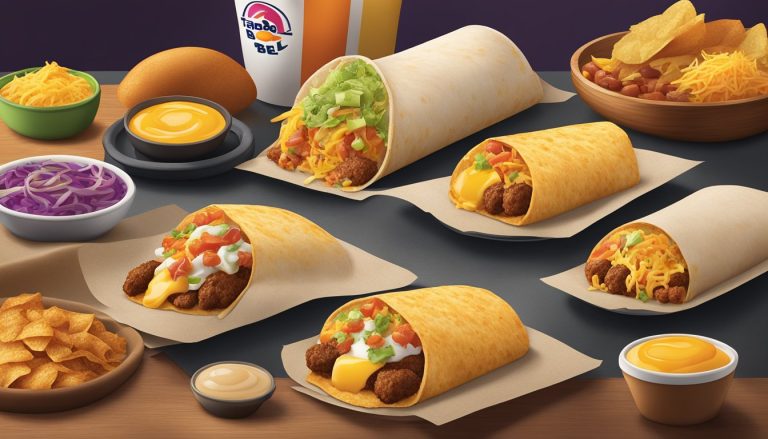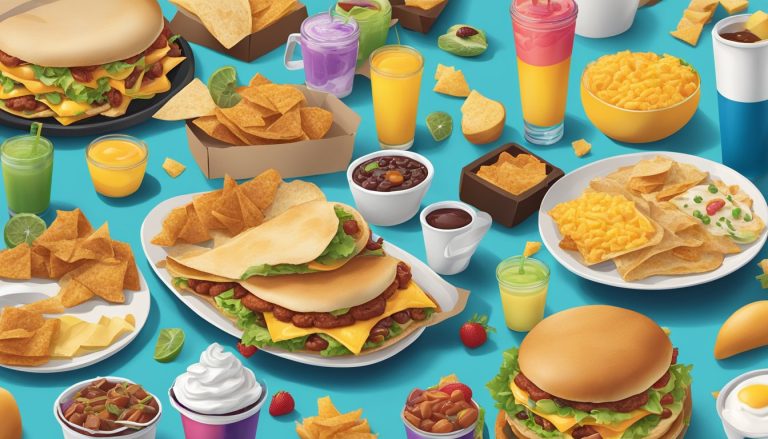Taco Bell’s foray into breakfast revolutionized the fast-food morning landscape. In 2014, the chain launched its nationwide breakfast menu, challenging traditional offerings with bold, portable options. The move marked a significant shift in fast-casual dining, catering to consumers seeking unique and convenient morning meals.
The introduction of Taco Bell’s breakfast menu was a calculated risk that paid off. Supported by an extensive marketing campaign, the new offerings quickly gained popularity among on-the-go consumers and breakfast enthusiasts. The menu’s focus on customization and creativity set it apart from competitors, appealing to those looking for alternatives to standard breakfast fare.
Taco Bell’s success in the breakfast arena sparked a trend in the fast-food industry. Other chains followed suit, expanding their morning offerings and extending breakfast hours. This shift reflected changing consumer preferences and lifestyles, with more people seeking diverse, quick, and affordable breakfast options outside the home.
The Emergence of Taco Bell’s Breakfast
Taco Bell‘s entry into the breakfast market marked a significant shift in fast-food dining. The company’s bold move introduced innovative menu items and challenged traditional breakfast offerings.
Historical Overview
Taco Bell, founded in 1962, had long been known for its Mexican-inspired fast food. The company’s journey into breakfast began in the 1980s with limited test runs. These early attempts included items like breakfast burritos and cinnamon crispas.
However, these initial forays did not lead to a full-scale breakfast launch. Taco Bell continued to focus on its core lunch and dinner offerings throughout the 1990s and early 2000s.
In 2012, Taco Bell began seriously exploring the breakfast market again. The company conducted extensive market research and product development to create a unique breakfast menu.
Significance of March 27, 2014
March 27, 2014, marked the official nationwide launch of Taco Bell’s breakfast menu. This date represented the culmination of years of planning and testing.
The launch was supported by Taco Bell’s largest marketing campaign to date. It included television commercials, social media promotions, and in-store advertising.
Key menu items introduced on this day included:
- Waffle Taco
- A.M. Crunchwrap
- Cinnabon Delights
These offerings were designed to appeal to Taco Bell’s core demographic of young adults seeking bold, unique flavors.
Breaking Into the Breakfast Daypart
Taco Bell’s entry into the breakfast daypart was a strategic move to capture a share of the lucrative morning market. The breakfast daypart had long been dominated by established players like McDonald’s and Dunkin’ Donuts.
To differentiate itself, Taco Bell focused on portability and customization. The Waffle Taco, for example, was designed to be easily eaten on-the-go.
Taco Bell’s breakfast menu also aimed to appeal to its existing customer base. By offering Mexican-inspired breakfast items, the company leveraged its brand identity in a new daypart.
The move into breakfast expanded Taco Bell’s operating hours. Many locations began opening at 6 a.m. to serve the morning crowd, increasing potential revenue.
Assessing Market Impact

Taco Bell’s entry into the breakfast market had significant effects on sales, consumer preferences, and the broader quick-service restaurant industry. The move reshaped morning dining habits and influenced competitors’ strategies.
Sales Growth and Market Share
Taco Bell’s breakfast launch drove substantial sales growth for the company. In the first year, breakfast items accounted for 6% of total sales, generating over $70 million in revenue. This figure grew to $500 million by 2018, representing about 9% of the chain’s U.S. sales.
The company captured an estimated 3% market share in the fast-food breakfast segment within three years of launch. This success came primarily at the expense of established players like McDonald’s and Burger King.
Breakfast sales helped boost Taco Bell’s overall performance, with same-store sales growth outpacing many competitors in the years following the launch.
Breakfast Burritos and Consumer Appeal
Taco Bell’s breakfast burritos emerged as a key driver of the menu’s success. The Breakfast Crunchwrap became an instant hit, accounting for 30% of morning sales in the first year.
Consumer research showed that 45% of Taco Bell’s breakfast customers were new to the chain or lapsed users. The unique offerings attracted younger demographics, with millennials making up 40% of breakfast traffic.
Menu innovation played a crucial role in maintaining consumer interest. Limited-time offers like the Naked Egg Taco and french toast chalupa generated buzz and drove repeat visits.
Influence on Quick-Service Industry
Taco Bell’s breakfast success prompted responses from competitors. McDonald’s expanded its all-day breakfast menu, while Wendy’s re-entered the breakfast market in 2020.
The launch highlighted the importance of differentiation in the crowded QSR breakfast space. Chains began focusing on unique items and flavor profiles to stand out.
Taco Bell’s success also influenced marketing strategies. Competitors increased ad spending during morning hours and targeted younger consumers more aggressively.
The broader impact extended to supply chains, with increased demand for breakfast ingredients leading to new supplier relationships across the industry.
Menu Innovation and Offerings
Taco Bell’s breakfast menu revolutionized fast-food morning offerings with creative Mexican-inspired dishes. The chain introduced unique items that set it apart from traditional breakfast fare, appealing to customers seeking bold flavors and new experiences.
Introduction to the Breakfast Menu
Taco Bell launched its nationwide breakfast menu on March 27, 2014. This expansion marked the largest menu addition in the company’s 50-year history. The move aimed to capture a share of the $50 billion limited-service breakfast market, previously dominated by competitors like McDonald’s.
The breakfast menu featured a mix of familiar ingredients and unexpected combinations. Taco Bell’s approach focused on portability and convenience, catering to on-the-go customers. The chain’s morning offerings reflected its commitment to thinking outside the box and challenging conventional breakfast norms.
Popular Breakfast Items
Taco Bell’s breakfast menu boasts several standout items that have gained popularity among customers:
- Breakfast Crunchwrap: A handheld twist on traditional breakfast sandwiches
- Cinnabon Delights: Bite-sized pastries filled with cream cheese frosting
- Breakfast Quesadillas: Cheese-filled tortillas with various protein options
- Breakfast Burritos: Portable wraps stuffed with eggs, cheese, and meats
The menu also includes unique offerings like the A.M. Grilled Taco and the Grande Toasted Breakfast Burrito. These items showcase Taco Bell’s ability to merge familiar breakfast ingredients with its signature Tex-Mex flavors.
Expansion and Evolution
Since its initial launch, Taco Bell has continued to innovate and expand its breakfast menu. The chain regularly introduces new items to keep customers engaged and attract new morning diners. Recent additions include:
- Breakfast Tots: A crispy potato side dish
- Mini Cinnis: A smaller version of cinnamon rolls
- Toasted Breakfast Burritos: A lineup of grilled, stuffed tortillas
Taco Bell also tests new breakfast offers through its digital channels, allowing for targeted promotions and limited-time specials. The company’s chief food innovation officer plays a crucial role in developing fresh ideas and menu concepts.
By 2016, just two years after its introduction, the breakfast menu accounted for 10% of Taco Bell’s business. This success demonstrates the chain’s ability to adapt to changing consumer preferences and carve out a significant niche in the competitive fast-food breakfast market.
Marketing and Consumer Engagement
Taco Bell’s breakfast launch relied on innovative marketing campaigns, strategic advertising, and strong franchisee partnerships. The company leveraged its brand identity to create buzz and drive consumer interest in its new morning offerings.
Launching the Breakfast Campaign
Taco Bell’s breakfast debut in 2014 marked a significant shift in the fast-food landscape. The company invested heavily in a nationwide marketing blitz to introduce its unique breakfast items. The campaign featured attention-grabbing slogans and eye-catching visuals that emphasized the distinctiveness of Taco Bell’s breakfast compared to traditional options.
Social media played a crucial role in generating excitement. Taco Bell used platforms like Twitter and Instagram to tease new menu items and engage directly with customers. The company also partnered with influential celebrities and social media personalities to amplify its message and reach a broader audience.
A key element of the launch was the focus on Taco Bell’s signature flavors and textures, adapted for breakfast. This strategy helped differentiate the brand from competitors and appealed to existing Taco Bell fans.
Advertising and Brand Strategies
Taco Bell’s advertising for breakfast centered on disrupting the morning routine. The company positioned its offerings as bold alternatives to conventional breakfast fare. TV commercials and digital ads featured playful jabs at competitors, particularly targeting market leader McDonald’s.
The brand leveraged its “Live Más” slogan to promote breakfast as an exciting, flavor-packed experience. This approach resonated with younger consumers who were seeking more adventurous food options.
Taco Bell also emphasized value in its marketing, promoting combo meals and affordable price points. This strategy aimed to attract budget-conscious consumers and compete with established breakfast providers.
To maintain momentum, Taco Bell regularly introduced limited-time offers and new menu items. These promotions kept the breakfast menu fresh and gave customers reasons to return.
Engaging with Franchisees
Taco Bell recognized the importance of franchisee support in successfully launching and maintaining its breakfast program. The company worked closely with franchisees to ensure smooth implementation across locations.
Training programs were developed to prepare staff for the new breakfast shift. These programs covered food preparation, customer service, and operational efficiency during morning hours.
Taco Bell provided marketing support to franchisees, including local advertising materials and promotional strategies. This helped create a consistent brand message across all locations.
The company also established communication channels for franchisees to provide feedback and share best practices. This collaborative approach helped refine the breakfast program and address challenges as they arose.
Business Strategies and Growth

Taco Bell’s pursuit of breakfast market share exemplifies its broader growth strategy. The company leverages key drivers, value-focused offerings, and expanded dayparts to fuel expansion and increase sales.
Identifying Key Drivers of Growth
Taco Bell recognizes innovation as a primary growth driver. The company regularly introduces unique menu items to attract customers and generate buzz. Brand partnerships also play a crucial role, with collaborations like the Doritos Locos Tacos driving significant sales increases.
Technological integration forms another key driver. Taco Bell invests in mobile ordering apps and kiosk systems to streamline operations and enhance customer experience. These initiatives reduce wait times and boost order accuracy.
Market expansion represents a third growth pillar. Taco Bell actively explores opportunities in international markets, adapting its menu to local tastes while maintaining core brand elements.
The Role of Value Menu
Taco Bell’s value menu serves as a cornerstone of its business strategy. The “$1 Cravings Menu” offers affordable options that appeal to budget-conscious consumers. This approach helps drive foot traffic and encourages customers to add higher-margin items to their orders.
The value menu also acts as a testing ground for new products. Successful items may graduate to the regular menu, while underperforming options can be quickly removed with minimal financial impact.
Taco Bell strategically adjusts its value offerings to maintain profitability. The company carefully balances low-cost items with higher-priced options to ensure a healthy profit margin across the entire menu.
Exploring Dayparts and Sales Opportunities
Taco Bell’s entry into the breakfast market exemplifies its strategy of capitalizing on underutilized dayparts. By offering morning menu items, the company aims to increase store utilization and boost overall sales.
The late-night segment represents another focus area. Taco Bell extends operating hours at many locations to capture post-dinner and late-night snacking occasions. This approach helps the company differentiate itself from competitors with more limited hours.
Seasonal promotions tied to specific dayparts, such as summer drink specials or holiday-themed menu items, further drive sales during traditionally slower periods. These limited-time offers create urgency and encourage repeat visits.
Operational Excellence

Taco Bell’s foray into breakfast hinged on streamlining operations, optimizing drive-thru service, and implementing sustainable practices. These initiatives aimed to enhance efficiency and customer satisfaction while minimizing environmental impact.
Efficiency in Fast Food Services
Taco Bell revamped its kitchen layouts to accommodate breakfast preparation without disrupting existing workflows. New equipment like high-speed toasters and egg cookers allowed for quick assembly of morning menu items. Staff received specialized training on breakfast procedures and multitasking during the morning rush.
The chain introduced a simplified breakfast menu to reduce complexity and speed up service times. Popular items like the Breakfast Crunchwrap and Cinnabon Delights became staples, balancing novelty with operational feasibility.
Taco Bell also implemented digital ordering systems to streamline the process. Mobile apps and kiosks allowed customers to customize orders efficiently, reducing wait times and human error.
Drive-Thru Optimization
Drive-thru service became crucial for breakfast success, as many customers sought quick meals on their way to work. Taco Bell invested in dual-lane drive-thrus at high-traffic locations to increase capacity and reduce wait times.
The company deployed digital menu boards with dynamic pricing and suggestive selling features. These boards adjusted in real-time based on factors like time of day and inventory levels.
Taco Bell introduced a “bell hop” system during peak hours. Staff equipped with tablets took orders from cars in line, speeding up the process and reducing bottlenecks at the speaker box.
Sustainability Initiatives
Taco Bell incorporated eco-friendly practices into its breakfast operations. The chain switched to recyclable and compostable packaging for many breakfast items, reducing waste.
Energy-efficient cooking equipment and LED lighting were installed to decrease power consumption during extended operating hours. Some locations piloted solar panels to offset increased energy usage from earlier opening times.
The company partnered with local coffee suppliers to source beans sustainably. This move supported small businesses and reduced transportation emissions associated with long-distance shipping.
Taco Bell also implemented food waste reduction programs, donating unsold breakfast items to local food banks and shelters when possible.




